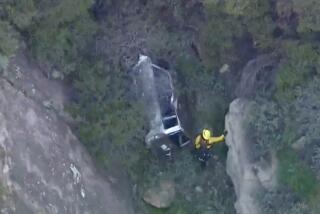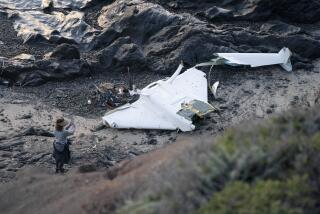Swiss hot-air balloon crash that killed Malibu scion rare in U.S.
The untimely death of Malibu’s wealthy scion in a hot-air balloon in Switzerland this week was just the latest in a series of deadly overseas crashes.
The deadly crash Tuesday that killed Grant Adamson, a member of Malibu’s founding family, occurred near the western Swiss town of Montbovon when the balloon hit power lines and fell 165 feet below.
Hot-air balloons use propane gas to heat the air that rises into what’s called “the envelope,” lifting the basket. Hot-air balloons in the U.S. are built to safety specifications, but they remain vulnerable to sudden changes in weather, which can lead to tragedy, particularly if the pilot miscalculates.
An investigation into what caused the Adamson crash -– which injured his wife and two daughters -- remained ongoing late Wednesday, but it was the latest fatal hot-air balloon incident overseas.
A hot-air balloon crash roughly two months ago in Turkey killed three tourists and injured 22 others.
And 19 people, most of them tourists, were killed in February when the hot-air balloon they were flying in over Egypt‘s ancient city of Luxor caught fire and crashed into a sugar cane field. The crash was attributed to a fire that started onboard, sending the balloon crashing about 1,000 feet.
In New Zealand last year, a hot air balloon accident killed 11 people.
Despite the headlines, here in the U.S. hot-air balloon crashes on the order of those seen abroad are relatively rare -– and even more so in California.
Ian Gregor, a spokesman for the Federal Aviation Administration, said the agency regulates hot-air balloons just as it does any other aircraft. That includes pilot and air-worthiness certifications, as well as regular inspections.
Of the 760 accidents in the U.S. since 1964, just 67 have been fatal, according to a USA Today analysis of National Transportation Safety Board records.
In California, there have been 27 hot-air balloon crashes over the last 20 years, resulting in five fatalities, according to an NTSB online database.
Here’s a brief rundown of the fatalities listed in the NTSB reports, which do not identify the victims:
April 13, 2007, Mecca, Calif.: High winds thrust a balloon through a section of power lines before the basket pounded against the ground twice, ejecting two passengers. The basket landed on top of one of them, and then dragged along the ground a few more feet before stopping.
Feb. 25, 2003, Yountville, Calif.: One man whose flight was canceled due to poor weather still ended up dead after a balloon demonstration went horribly wrong.
The man had joined in with several others to help hold down the rope system so that the pilot could suspend the balloon just above the ground and passengers could photograph the craft “in flight.”
But after a series of mishaps and sudden loss of weight, the craft unexpectedly ascended from about 5 feet to 100 feet. Meanwhile, ground crews realized the man was holding onto the balloon itself, not the ropes. After a short time, he let go and fell to his death.
Toxicology tests later revealed “significant impairment” from marijuana use.
June 9, 1999, Morgan Hill, Calif.: Two passengers burned to death after the hot-air balloon they were riding drifted into power lines, which shorted and arced. An “unapproved” aluminum fuel tank in the basket ruptured and ignited the basket and balloon envelope.
The pilot jumped from the basket and sustained serious injuries. His passengers “succumbed to thermal injuries.”
July 3, 1995, Davis, Calif.: One passenger was killed during a hard landing in which the basket bounced hard off the ground twice, ejecting three occupants. No cause of death was listed.
ALSO:
Ariel Castro’s house of horror demolished in Cleveland
Death of obese Ohio inmate escalates death penalty debate
Attorney says Ft. Hood shooter trying to ‘achieve’ death penalty
Follow: @jasonbretwells / Facebook / Google+
More to Read
Start your day right
Sign up for Essential California for news, features and recommendations from the L.A. Times and beyond in your inbox six days a week.
You may occasionally receive promotional content from the Los Angeles Times.






